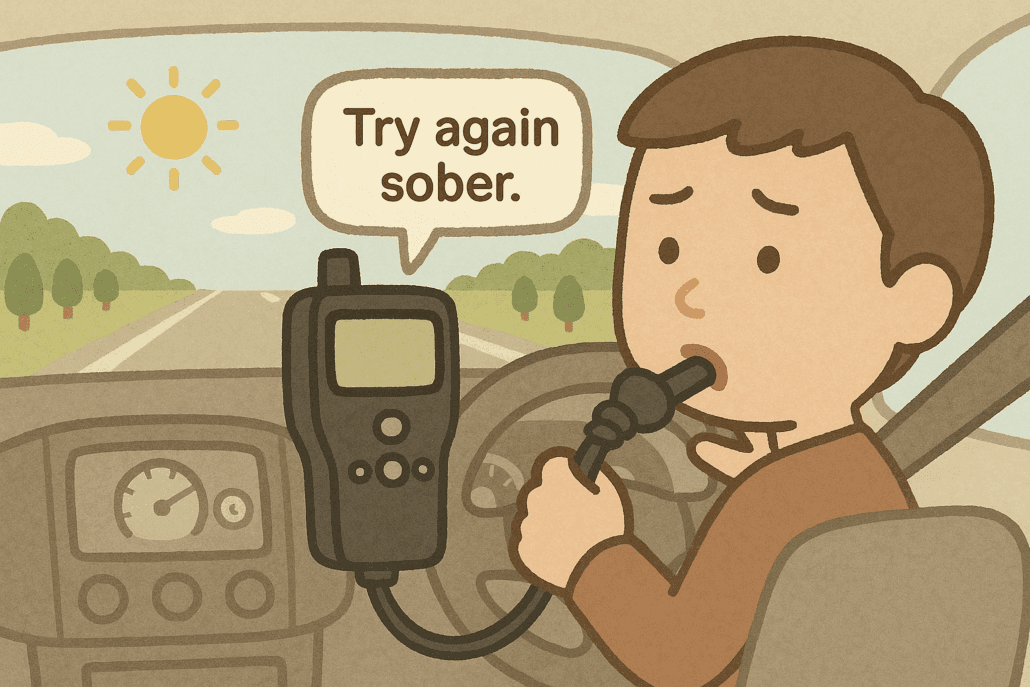Effectiveness of Ignition Interlock Devices in Reducing Drunk Driving
Drunk driving remains a serious safety issue on U.S. roads, claiming thousands of lives each year. Ignition interlock devices – in-car breathalyzers that prevent a vehicle from starting if the driver has been drinking – have emerged as a key tool to combat this problem. How effective are these devices in reducing drunk driving incidents? Below we explore what ignition interlocks are, how they work, the laws and statistics surrounding their use (nationally and in Oregon), and what the research says about their impact on road safety.
What Are Ignition Interlock Devices and How Do They Work?
An ignition interlock device (IID) is essentially a breathalyzer installed in a vehicle. Before the engine starts, the driver must exhale into the device to provide a breath sample. If the device detects a blood alcohol concentration (BAC) above the programmed limit (commonly set very low, around 0.02% BAC), the ignition is locked and the vehicle won’t start. This mechanism physically prevents an intoxicated person from driving their car. Modern interlocks are electronic, handheld units typically mounted near the driver’s seat, and many have digital displays and cameras to verify the user’s identity. In practice, an IID lets drivers who must drive (for work, family, etc.) do so only when sober, effectively acting as a gatekeeper every time the person gets behind the wheel.
Drunk Driving in the U.S. and Oregon: Why Interlocks Matter
Drunk driving is not a trivial issue – it’s a nationwide concern. In 2023 alone, 12,429 people were killed in alcohol-impaired driving crashes in the U.S., about one life lost every 42 minutes. On average, around 11,000 lives have been lost per year over the past decade due to drunk-driving incidents. These sobering statistics underscore why measures like ignition interlock devices are so important for public safety.
In Oregon, as in other states, drunk driving (often legally termed DUII – Driving Under the Influence of Intoxicants) has prompted strong preventive measures. Alcohol-impaired driving accounts for a significant portion of traffic fatalities and injuries each year in Oregon, and authorities have continually looked for ways to reduce these tragedies. One key strategy has been the widespread use of ignition interlock devices for DUII offenders, to stop convicted drunk drivers from re-offending and endangering others on the road. By requiring interlocks, Oregon aims to protect not just the offenders themselves, but everyone sharing the road with them.
Ignition Interlock Laws: Oregon and Nationwide
Ignition interlock requirements have become standard penalties for DUI offenses across the United States. All 50 states now have some form of ignition interlock program or law in place, though the specifics vary. In many states, interlocks are mandatory for certain offenders (such as repeat DUI drivers or those with very high BAC levels). Oregon’s approach is among the stricter and more comprehensive. In Oregon, anyone convicted of a DUII – even a first offense – is generally required to install an IID in any vehicle they drive once they regain driving privileges. In fact, Oregon passed a law back in 2007 mandating interlocks for many offenders, and in 2011 the law was strengthened to require IIDs even for first-time offenders who enter a diversion program. This closed a loophole and essentially means most people charged with DUII in Oregon (whether through conviction or diversion) will need an interlock before they can legally drive again.
Under Oregon law, a first-time DUII offender typically must use an ignition interlock for a minimum of one year. (This often applies whether the person is convicted or is in a court-approved diversion program in lieu of conviction.) Repeat offenders face longer IID requirements – for example, a second offense may require at least two years with the device, and additional offenses can lead to five-year interlock mandates. The device must be kept in the vehicle and regularly serviced/calibrated during that period, and the driver’s performance (any failed tests, etc.) may be reported to authorities. These rules underscore Oregon’s commitment to keeping impaired drivers off the road.
Nationally, there is a trend toward Oregon’s all-offender model. As of early 2024, 31 states and the District of Columbia have laws requiring all convicted DUI offenders (including first-timers) to install ignition interlocks. Other states impose interlocks only on specific cases – for instance, 8 states mandate them for high-BAC or repeat offenders, and a few states still leave interlock installation to a judge’s discretion in each case. Oregon is firmly in the camp of “all-offender” ignition interlock states, aligning with what safety advocates (like Mothers Against Drunk Driving, MADD) recommend across the board. This proactive approach puts Oregon on par with the majority of states that have embraced interlocks as a preventive measure for every drunk driving offender, rather than only the worst cases.
How Oregon’s Approach Compares
Oregon’s ignition interlock program is quite robust compared to some states. By requiring interlocks even for first DUII offenses, Oregon joins those states that take a zero-tolerance stance on drunk driving recidivism. Some states still do not mandate interlocks for first offenses or have shorter required durations, which can lead to inconsistency in enforcement. The data suggests that broader use of interlocks yields better safety outcomes: for example, one analysis found that states requiring interlocks for all offenders had 26% fewer alcohol-impaired drivers in fatal crashes than states with no interlock law. Oregon’s all-offender policy is exactly the kind of law this statistic points to. In other words, Oregon’s approach likely contributes to fewer deadly crashes, on par with the best-performing states on this metric. By contrast, states with more limited interlock requirements (only for repeat or extreme BAC offenders) have seen smaller reductions (around 20% fewer impaired drivers in fatal crashes compared to having no interlock law). The comparison highlights that Oregon’s comprehensive use of IIDs is a nationally recommended strategy to curb drunk driving.
It’s also worth noting that Oregon’s enforcement extends to those who choose diversion (an alternative program often available to first offenders to avoid a conviction by completing treatment and meeting certain requirements). Oregon closed the diversion loophole in 2011, ensuring that even drivers in diversion must install an IID. Not all states do this. By “covering all the bases” – diversion or conviction – Oregon casts a wide net, whereas in some states a first-time offender might avoid an interlock by taking a similar diversion deal. Oregon’s higher standards reflect an understanding that any drunk driving incident is serious and merits preventive measures to stop it from happening again.
Do Ignition Interlocks Actually Reduce Drunk Driving?
The big question for many is whether these devices truly make a difference. Research and real-world data say yes – ignition interlock devices are effective at reducing drunk driving, especially repeat offenses. Consider some key findings:
- Significant Drop in Repeat DUIs: Studies show that while an IID is installed, re-arrest rates for DUI drop about 70% among offenders, compared to those who don’t have interlocks. In plain terms, someone with a history of drunk driving is much less likely to do it again if they’re physically prevented from starting their car while intoxicated. That’s a huge reduction in risk during the period of installation.
- Fewer Alcohol-Related Crashes: States that widely implemented interlocks have seen declines in alcohol-related crash fatalities. As mentioned, states requiring interlocks for all DUI offenders experienced roughly a 26% lower rate of drunk drivers in fatal crashes versus states without interlock laws. Even states with partial interlock mandates saw benefits (around 20% reduction). This suggests that IIDs contribute to saving lives on a broader scale, not just preventing individual offenses.
- Preventing Thousands of Incidents: Ignition interlocks actively stop would-be drunk driving attempts. From 2006 to 2020, interlock devices nationwide prevented approximately 3.78 million attempts by drivers to start vehicles while over the legal alcohol limit. In the year 2020 alone, about 390,000 drunken start attempts were blocked by IIDs across the U.S.. That’s hundreds of thousands of potential intoxicated drives averted in a single year. Oregon contributes its share to these statistics – for example, tens of thousands of unsafe starts have been halted by interlocks in Oregon over the past decade or so, undoubtedly preventing many possible crashes.
While these devices clearly work when in use, it’s important to understand their limits too. The presence of an IID directly prevents a person from driving drunk in their own vehicle. However, the effect can be temporary if the root cause of the behavior (alcohol misuse, addiction, etc.) isn’t addressed. Studies have noted that the drop in recidivism tends to last only while the device is installed in the offender’s car. Once the IID is removed, if the individual hasn’t made lasting changes, they could revert to old habits (since the physical barrier is gone). In response, many jurisdictions – including Oregon – use interlocks in combination with treatment programs, education, and monitoring to encourage long-term behavior change. Some states have “compliance-based removal” laws, meaning offenders must show a period of clean, violation-free IID use before they are allowed to remove the device. These measures aim to extend the positive effects of interlocks even after they come off.
Overall, the consensus is that ignition interlocks are one of the most effective tools available to reduce repeat drunk driving. They are not a standalone silver bullet (because determined individuals might find ways around them, or may relapse later), but during the period an IID is required, the driver and the public are far safer. And when used broadly, interlocks contribute to a measurable decline in alcohol-related crashes and deaths – meaning families are spared devastating news and our roads are generally less dangerous.
Safer Roads and Public Benefits of Interlock Devices
For the public at large, the rise of ignition interlock devices has been a net win for road safety. These devices create immediate, real-world protection: if a person who has a history of DUI tries to drink and drive, the interlock will stop them on the spot. That could be preventing your would-be drunk neighbor from unintentionally plowing through a crosswalk, or keeping an intoxicated driver from causing a head-on collision on the highway. In essence, every prevented start is a potential accident that didn’t happen.
There are several practical benefits to the widespread use of interlocks:
- Reduced Repeat Offenses: As discussed, offenders are much less likely to get arrested for DUI again while on an interlock program. This means fewer drunk drivers on the road at any given time, which benefits everyone who drives, bikes, or walks on those roads.
- Behavior Change: Having to drive with an interlock can be a learning experience. Offenders often must demonstrate months of sober driving before the device comes off, which can help break the cycle of drunk driving. It conditions individuals to plan ahead (e.g. not drinking if they need to drive) and can reinforce safer habits.
- Accountability: Interlocks provide a level of accountability that license suspensions alone may not. Many DUI offenders drive on suspended licenses anyway; an IID, however, leaves a digital record. Failed breath tests, attempts to tamper with the device, and any maintenance issues are logged. Offenders know they are being monitored, which can dissuade risky behavior. In Oregon, for instance, a person must get a certificate of compliance (showing they had no violations on the interlock) before the requirement is lifted. This ensures the driver proved their ability to stay sober behind the wheel.
- Safety Without Completely Revoking Driving Privileges: Interlocks strike a balance between punishment and rehabilitation. Instead of completely banning someone from driving (which can impact their employment and family responsibilities), an IID allows them to continue driving safely. They can commute to work, attend treatment programs, and carry on with life, but with the safeguard that they cannot drink and drive. This is beneficial for the individual’s rehabilitation and for society – it reduces the likelihood of illegal driving or economic hardship that might come from a totally revoked license.
From a realistic perspective, ignition interlocks are not foolproof. They require the offender’s vehicle to be the one equipped, so if someone has access to another car without an IID, that’s a vulnerability. Additionally, some hard-core offenders have attempted to cheat the devices (for example, having someone else blow for them), though modern interlocks often include cameras or other features to prevent circumvention. Despite these limitations, interlocks undeniably raise the barrier to drunk driving. A person with an IID can’t just impulsively drive home drunk from a bar; the device forces a pause and effectively says, “Not this car, not tonight.” In many cases, that pause is enough to deter the behavior or at least force the person to find another (sober) way home.
Importantly, ignition interlock devices have strong support from safety organizations and traffic authorities. Groups like MADD advocate for “all offender” interlock laws in every state, citing the devices’ life-saving potential. There’s also movement at the federal level: technology is evolving such that in the future, new cars may come with built-in alcohol detection systems. In fact, federal legislation has encouraged advanced impaired driving prevention technology in vehicles, which could make interlocks (or similar systems) a standard feature in coming years. The ultimate vision is a world where every car can detect impairment and refuse to operate for a drunk driver – effectively eliminating drunk driving crashes altogether. While we’re not quite there yet, today’s ignition interlocks are a significant step toward that safer future.
When Legal Support Is Needed
Ignition interlock devices are just one part of the solution to drunk driving. They help keep our roads safer and give individuals a chance to correct their behavior. Nevertheless, DUI incidents and alcohol-related crashes still happen. If you or a loved one has been injured by a drunk driver – or if you find yourself facing legal challenges related to a DUI or accident – you may need professional legal support. This is where a law firm like Johnson Law, P.C. can step in. We understand the impacts that drunk driving accidents have on victims and families in Oregon. Our experienced personal injury team has seen firsthand how tools like interlocks make a difference, and we’re here to help when the worst occurs despite these precautions.
At Johnson Law, P.C., we are committed to supporting our community’s safety and well-being. If you have questions about your rights after a DUI-related accident or need advice on the legal implications of a drunk driving charge, feel free to reach out to us. Our firm is based in Oregon and deeply familiar with local DUII laws, including ignition interlock requirements and how they factor into cases. We believe that everyone deserves justice and support, especially when harmed by someone else’s negligence. Ignition interlock devices are making our roads safer and reducing drunk driving – but if you ever need legal help in the context of a DUI or auto accident, know that we are here to help you navigate the road ahead.
Sources:
- Centers for Disease Control and Prevention (CDC) – Ignition interlock facts and effectiveness
- National Highway Traffic Safety Administration (NHTSA) – Drunk driving statistics (2023)
- National Conference of State Legislatures – Summary of state ignition interlock laws (2024)
- Mothers Against Drunk Driving (MADD) – Oregon interlock law background
- Oregon State Police – IID requirements for diversion and convictions
- Insurance Institute for Highway Safety (IIHS) – Interlock effectiveness on recidivism
- MADD Ignition Interlock Report (2021) – Interlocks preventing drunk starts


